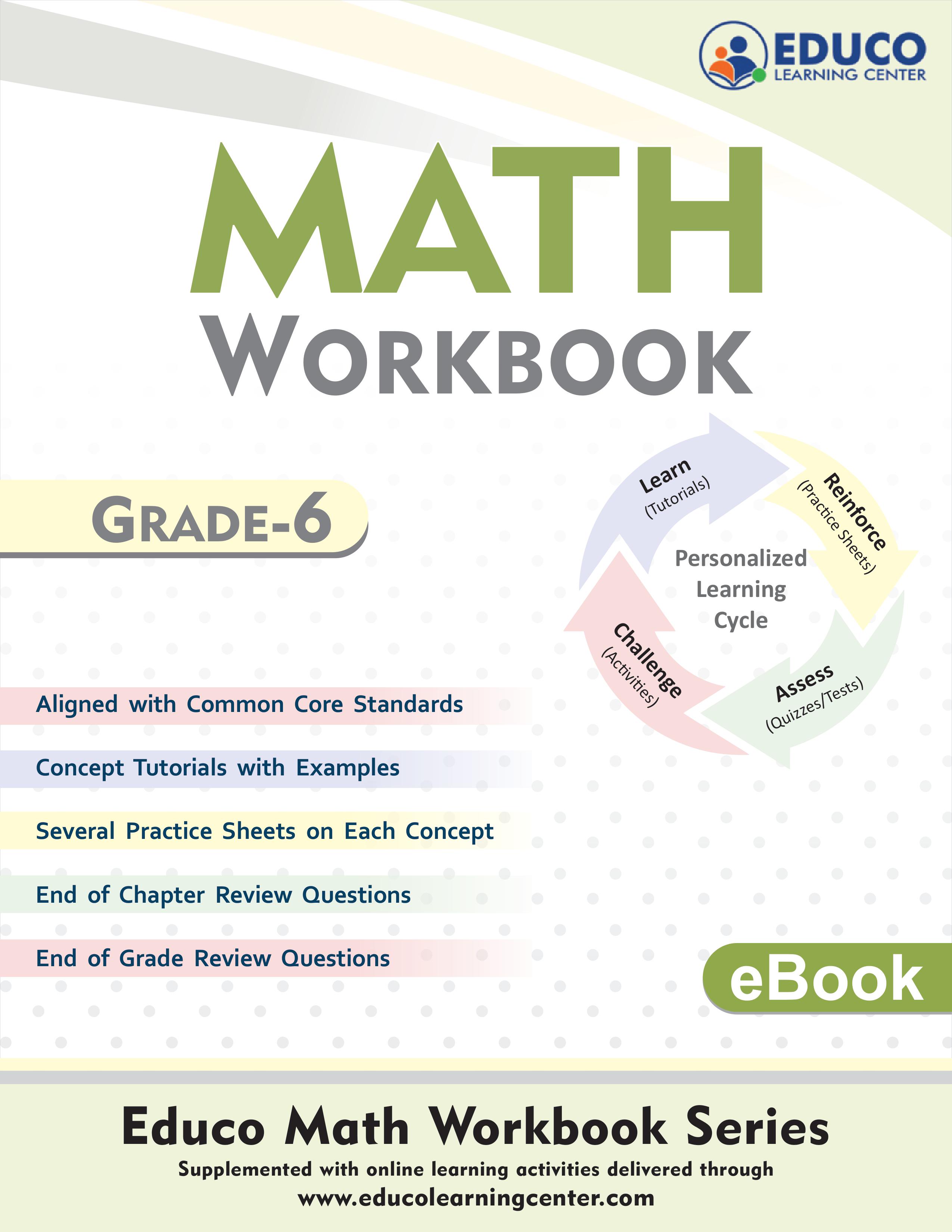Grade 6 Mathematics Course Details
Building unique learning experiences with the courses mapped to the national standards.
Course Metrics
-
 Skills
155
Skills
155 -
 Tutorials
115
Tutorials
115 -
 Video Lessons
66
Video Lessons
66 -
 Examples
201
Examples
201 -
 Free Response Questions
4860
Free Response Questions
4860 -
 Multiple Choice Questions
855
Multiple Choice Questions
855 -
 Online Practice Assessments
36
Online Practice Assessments
36 -
 Offline Practice Sheets (print)
88
Offline Practice Sheets (print)
88 -
 Graded Assessments
38
Graded Assessments
38
Overview
The Grade 6 Math curriculum at Educo Learning Center (ELC) covers essential topics aligned with the Common Core standards. The Grade 6 Math topics include connecting ratio and rate to whole number multiplication and division, completing understanding of division of fractions, extending the notion of numbers to the system of rational numbers (which includes negative numbers), writing, interpreting, and utilizing expressions and equations, and developing a sense of statistical reasoning.
The Educo Learning Center Grade 6 Math uses visual simulations to help your child visualize concepts being taught. Grade 6 Math lecture notes and practice resources follow a stepwise learning process to help students understand concepts better, recognize mistakes, and eventually develop strategies for tackling future problems.
"I Can" Statements For Math Grade 6
| Standard | 6.RP.A.1 |
|---|---|
| Standard Description | 1. Understand the concept of a ratio and use ratio language to describe a ratio relationship between two quantities. For example, “The ratio of wings to beaks in the birdhouse at the zoo was 2:1, because, for every 2 wings, there was 1 beak.” "For every vote candidate A received, candidate C received nearly three votes." |
| Online Corse Hierarchy | 2.1 |
| I Can Statements | I can understand the concept of a ratio and use ratio language to describe a ratio relationship between two quantities. |
| Standard | 6.RP.A.2 |
|---|---|
| Standard Description | 2. Understand the concept of a unit rate a/b associated with a ratio a:b with b ≠ 0, and use rate language in the context of a ratio relationship. For example, “This recipe has a ratio of 3 cups of flour to 4 cups of sugar, so there is 3/4 cup of flour for each cup of sugar.” “We paid $75 for 15 hamburgers, which is a rate of $5 per hamburger.” |
| Online Corse Hierarchy | 2.1 |
| I Can Statements | I can understand the concept of a unit rate a/b associated with a ratio a:b with b ≠ 0, and use rate language in the context of a ratio relationship. |
| Standard | 6.RP.A.3 |
|---|---|
| Standard Description | 3. Use ratio and rate reasoning to solve real-world and mathematical problems, e.g., by reasoning about tables of equivalent ratios, tape diagrams, double number line diagrams, or equations. |
| Standard | 6.RP.A.3a |
|---|---|
| Standard Description | a. Make tables of equivalent ratios relating quantities with whole-number measurements, find missing values in the tables, and plot the pairs of values on the coordinate plane. Use tables to compare ratios. |
| Online Corse Hierarchy | 2.1 |
| I Can Statements | I can make tables of equivalent ratios relating quantities with whole-number measurements, find missing values in the tables, and plot the pairs of values on the coordinate plane; use tables to compare ratios. |
| Standard | 6.RP.A.3b |
|---|---|
| Standard Description | b. Solve unit rate problems involving unit pricing and constant speed. For example, if it took 7 hours to mow 4 lawns, then at that rate, how many lawns could be mowed in 35 hours? At what rate were lawns being mowed? |
| Online Corse Hierarchy | 2.1 |
| I Can Statements | I can solve unit rate problems, including those involving unit pricing and constant speed etc. |
| Standard | 6.RP.A.3c |
|---|---|
| Standard Description | c. Find a percent of a quantity as a rate per 100 (e.g., 30% of a quantity means 30/100 times the quantity); solve problems involving finding the whole, given a part, and the percent. |
| Online Corse Hierarchy | 2.2 |
| I Can Statements | I can convert Percent - Fraction - Decimals. I can find a percent of a quantity as a rate per 100. I can solve problems involving finding the whole, given a part, and the percent |
| Standard | 6.RP.A.3d |
|---|---|
| Standard Description | d. Use ratio reasoning to convert measurement units; manipulate and transform units appropriately when multiplying or dividing quantities. |
| Online Corse Hierarchy | 3.1 |
| I Can Statements | I can use ratio reasoning to convert customary measurement units |
| Online Corse Hierarchy | 3.2 |
| I Can Statements | I can use ratio reasoning to convert metric measurement units |
| Standard | 6.NS.A.1 |
|---|---|
| Standard Description | 1. Interpret and compute quotients of fractions, and solve word problems involving the division of fractions by fractions, e.g., by using visual fraction models and equations to represent the problem. For example, create a story context for (2/3) ÷ (3/4) and use a visual fraction model to show the quotient; use the relationship between multiplication and division to explain that (2/3) ÷ (3/4) = 8/9 because 3/4 of 8/9 is 2/3. (In general, (a/b) ÷ (c/d) = ad/bc.) How much chocolate will each person get if 3 people share 1/2 lb of chocolate equally? How many 3/4-cup servings are in 2/3 of a cup of yogurt? How wide is a rectangular strip of land with a length of 3/4 mi and an area of 1/2 square mi? |
| Online Corse Hierarchy | 1.1 |
| I Can Statements | I can interpret and compute quotients of fractions and solve word problems involving the division of fractions by fractions, e.g., by using visual fraction models and equations to represent the problem. |
| Standard | 6.NS.B.2 |
|---|---|
| Standard Description | 2. Fluently divide multi-digit numbers using the standard algorithm. |
| Online Corse Hierarchy | 1.2 |
| I Can Statements | I can fluently divide multi-digit numbers using the standard algorithm. I can estimate quotients by front-end rounding. |
| Standard | 6.NS.B.3 |
|---|---|
| Standard Description | 3. Fluently add, subtract, multiply, and divide multi-digit decimals using the standard algorithm for each operation. |
| Online Corse Hierarchy | 1.3 |
| I Can Statements | I can fluently add and subtract multi-digit decimals using the standard algorithm for each operation and do estimation. |
| Online Corse Hierarchy | 1.4 |
| I Can Statements | I can fluently multiply and divide multi-digit decimals using the standard algorithm for each operation and do the estimation. |
| Standard | 6.NS.B.4 |
|---|---|
| Standard Description | 4. Find the greatest common factor of two whole numbers less than or equal to 100 and the least common multiple of two whole numbers less than or equal to 12. Use the distributive property to express a sum of two whole numbers 1–100 with a common factor as a multiple of a sum of two whole numbers with no common factor.
For example, express 36 + 8 as 4 (9 + 2) |
| Online Corse Hierarchy | 1.3 |
| I Can Statements | I can fluently add and subtract multi-digit decimals using the standard algorithm for each operation and do estimation. |
| Online Corse Hierarchy | 1.5 |
| I Can Statements | I can check the divisibility of numbers using divisibility tests. I can identify prime and composite numbers. I can write the Prime factorization of numbers. I can find factors, multiples, GCF, and LCM. I can factor out GCF using the distributive property. |
| Standard | 6.NS.C.5 |
|---|---|
| Standard Description | 5. Understand that positive and negative numbers are used together to describe quantities having opposite directions or values (e.g., temperature above/below zero, elevation above/below sea level, credits/debits, positive/negative electric charge); use positive and negative numbers to represent quantities in real-world contexts, explaining the meaning of 0 in each situation |
| Online Corse Hierarchy | 1.6 |
| I Can Statements | I can understand that positive and negative numbers are used together to describe quantities with opposite directions or values. |
| Standard | 6.NS.C.6 |
|---|---|
| Standard Description | 6. Understand a rational number as a point on the number line. Extend number line diagrams and coordinate axes familiar from previous grades to represent points on the line and in the plane with negative number coordinates. a. Recognize opposite signs of numbers as indicating locations on opposite sides of 0 on the number line; recognize that the opposite of a number is the number itself, e.g., –(–3) = 3, and that 0 is its own opposite. b. Understand signs of numbers in ordered pairs as indicating locations in quadrants of the coordinate plane; recognize that when two ordered pairs differ only by signs, the locations of the points are related by reflections across one or both axes. c. Find and position integers and other rational numbers on a horizontal or vertical number line diagram; find and position pairs of integers and other rational numbers on a coordinate plane. |
| Online Corse Hierarchy | 1.6 |
| I Can Statements | I can graph an integer as a point on the number line. |
| Standard | 6.NS.C.7 |
|---|---|
| Standard Description | 7. Understand the ordering and absolute value of rational numbers a. Interpret statements of inequality as statements about the relative position of two numbers on a number line diagram. For example, interpret –3 > –7 as a statement that –3 is located to the right of –7 on a number line oriented from left to right. b. Write, interpret, and explain statements of order for rational numbers in real-world contexts. For example, write –3 deg C > –7 deg C to express the fact that –3 deg C is warmer than –7 deg C. c. Understand the absolute value of a rational number as its distance from 0 on the number line; interpret absolute value as magnitude for a positive or negative quantity in a real-world situation. For example, for an account balance of –30 dollars, write |–30| = 30 to describe the size of the debt in dollars. d. Distinguish comparisons of absolute value from statements about order. For example, recognize that an account balance of less than –30 dollars represents a debt greater than 30 dollars. |
| Online Corse Hierarchy | 1.6 |
| I Can Statements | I can compare and order integers. I can find the absolute value of integers. |
| Standard | 6.NS.C.8 |
|---|---|
| Standard Description | 8. Solve real-world and mathematical problems by graphing points in all four coordinate plane quadrants. Include using coordinates and absolute value to find distances between points with the same first coordinate or the same second coordinate. |
| Online Corse Hierarchy | 1.7 |
| I Can Statements | I can plot points in all four quadrants of the coordinate plane. I can use coordinates and absolute values to find distances between points with the same first coordinate or the same second coordinate. |
| Standard | 6.EE.A.1 |
|---|---|
| Standard Description | 1. Write and evaluate numerical expressions involving whole-number exponents. |
| Online Corse Hierarchy | 4.2 |
| I Can Statements | I can interpret the exponential form of the product of whole numbers. I can simplify numerical expressions involving whole-number exponents |
| Standard | 6.EE.A.2 |
|---|---|
| Standard Description | 2. Write, read, and evaluate expressions in which letters stand for numbers. a. Write expressions that record operations with numbers and with letters standing for numbers. For example, express the calculation “Subtract y from 5” as 5 – y. b. Identify parts of an expression using mathematical terms (sum, term, product, factor, quotient, coefficient); view one or more parts of an expression as a single entity. For example, describe the expression 2 (8 + 7) as a product of two factors; view (8 + 7) as both a single entity and a sum of two terms. c. Evaluate expressions at specific values of their variables. Include expressions that arise from formulas used in real-world problems. Perform arithmetic operations, including those involving whole-number exponents, in the conventional order when there are no parentheses to specify a particular order (Order of Operations). For example, use the formulas V = s^3 and A = 6 s^2 to find a cube's volume and surface area with sides of length s = 1/2. |
| Online Corse Hierarchy | 4.2 |
| I Can Statements | I can identify parts of an expression: coefficients, variables, and terms. I can evaluate expressions at specific values of their variables. |
| Standard | 6.EE.A.3 |
|---|---|
| Standard Description | 3. Apply the properties of operations to generate equivalent expressions. For example, apply the distributive property to the expression 3 (2 + x) to produce the equivalent expression 6 + 3x; apply the distributive property to the expression 24x + 18y to produce the equivalent expression 6 (4x + 3y); apply properties of operations to y + y + y to produce the equivalent expression 3y |
| Online Corse Hierarchy | 4.3 |
| I Can Statements | I can write equivalent expressions by combining like terms or using the distributive property. |
| Standard | 6.EE.A.4 |
|---|---|
| Standard Description | 4. Identify when two expressions are equivalent (i.e., when the two expressions name the same number regardless of which value is substituted). For example, the expressions y + y + y and 3y are equivalent because they name the same number regardless of which number y stands for. |
| Online Corse Hierarchy | 4.3 |
| I Can Statements | I can identify when two expressions are equivalent or not. |
| Standard | 6.EE.B.5 |
|---|---|
| Standard Description | 5. Understand solving an equation or inequality as a process of answering a question: which values from a specified set, if any, make the equation or inequality true? Use substitution to determine whether a given number in a specified set makes an equation or inequality true. |
| Online Corse Hierarchy | 4.4 |
| I Can Statements | I can use substitution to determine whether a given number in a specified set makes an equation true. |
| Standard | 6.EE.B.6 |
|---|---|
| Standard Description | 6. Use variables to represent numbers and write expressions when solving a real-world or mathematical problem; understand that a variable can represent an unknown number or, depending on the purpose, any number in a specified set. |
| Online Corse Hierarchy | 4.4 |
| I Can Statements | I can solve one-step equations in one variable using addition and division properties. |
| Standard | 6.EE.B.7 |
|---|---|
| Standard Description | 7. Solve real-world and mathematical problems by writing and solving equations of the form x + p = q and px = q for cases in which p, q, and x are all nonnegative rational numbers |
| Online Corse Hierarchy | 4.4 |
| I Can Statements | I can solve real-world and mathematical problems by writing and solving equations of the form “x ± p = q” and "px = q" for cases in which p, q, and x are all nonnegative rational numbers. |
| Standard | 6.EE.B.8 |
|---|---|
| Standard Description | 8. Write an inequality of the form x > c or x < c to represent a constraint or condition in a real-world or mathematical problem. Recognize that inequalities of form x > c or x < c have infinitely many solutions; represent solutions of such inequalities on number line diagrams. |
| Online Corse Hierarchy | 4.5 |
| I Can Statements | I can use substitution to determine whether a given number in a specified set makes an inequality true. I can recognize that inequalities of the form “x > c” or "x < c" has infinitely many solutions; it represents solutions of such inequalities on a number line. I can write an inequality of the form “x > c” or “x < c” to represent a constraint or condition in a real-world or mathematical problem. |
| Standard | 6.EE C.9 |
|---|---|
| Standard Description |
9. Use variables to represent two quantities in a real-world problem that change in relationship to one another; write an equation to express one quantity, thought of as the dependent variable, in terms of the other quantity, thought of as the independent variable. Analyze the relationship between the dependent and independent variables using graphs and tables, and relate these to the equation. For example, in a problem involving motion at a constant speed, list and graph ordered pairs of distances and times and write the equation d = 65t to represent the relationship between distance and time. |
| Online Corse Hierarchy | 4.6 |
| I Can Statements | I can use variables to represent two quantities in a real-world problem that change in relationship to one another; write an equation to express one quantity, thought of as the dependent variable, in terms of the other quantity, thought of as the independent variable. I can analyze the relationship between the dependent and independent variables using graphs & tables and relate these to the equation. |
| Standard | 6.NS.C.6 |
|---|---|
| Standard Description | 6. Understand a rational number as a point on the number line. Extend number line diagrams and coordinate axes familiar from previous grades to represent points on the line and in the plane with negative number coordinates. a. Recognize opposite signs of numbers as indicating locations on opposite sides of 0 on the number line; recognize that the opposite of a number is the number itself, e.g., –(–3) = 3, and that 0 is its own opposite. b. Understand signs of numbers in ordered pairs as indicating locations in quadrants of the coordinate plane; recognize that when two ordered pairs differ only by signs, the locations of the points are related by reflections across one or both axes. c. Find and position integers and other rational numbers on a horizontal or vertical number line diagram; find and position pairs of integers and other rational numbers on a coordinate plane. |
| Online Corse Hierarchy | 1.6 |
| I Can Statements | I can graph an integer as a point on the number line. |
| Standard | 6.NS.C.7 |
|---|---|
| Standard Description | 7. Understand the ordering and absolute value of rational numbers a. Interpret statements of inequality as statements about the relative position of two numbers on a number line diagram. For example, interpret –3 > –7 as a statement that –3 is located to the right of –7 on a number line oriented from left to right. b. Write, interpret, and explain statements of order for rational numbers in real-world contexts. For example, write –3 deg C > –7 deg C to express the fact that –3 deg C is warmer than –7 deg C. c. Understand the absolute value of a rational number as its distance from 0 on the number line; interpret absolute value as magnitude for a positive or negative quantity in a real-world situation. For example, for an account balance of –30 dollars, write |–30| = 30 to describe the size of the debt in dollars. d. Distinguish comparisons of absolute value from statements about order. For example, recognize that an account balance of less than –30 dollars represents a debt greater than 30 dollars. |
| Online Corse Hierarchy | 1.6 |
| I Can Statements | I can compare and order integers. I can find the absolute value of integers. |
| Standard | 6.NS.C.8 |
|---|---|
| Standard Description | 8. Solve real-world and mathematical problems by graphing points in all four coordinate plane quadrants. Include using coordinates and absolute value to find distances between points with the same first coordinate or the same second coordinate. |
| Online Corse Hierarchy | 1.7 |
| I Can Statements | I can plot points in all four quadrants of the coordinate plane. I can use coordinates and absolute values to find distances between points with the same first coordinate or the same second coordinate. |
| Standard | 6.G.A.1 |
|---|---|
| Standard Description | 1. Find the area of right triangles, other triangles, special quadrilaterals, and polygons by composing them into rectangles or decomposing them into triangles and other shapes; apply these techniques in the context of solving real-world and mathematical problems. |
| Online Corse Hierarchy | 5.1 |
| I Can Statements | I can find the perimeter of polygons. I can find the area of rectangles and squares. I can find the area of right triangles, other triangles, special quadrilaterals, and polygons by composing them into rectangles or decomposing them into triangles and other shapes |
| Standard | 6.EE.A.2 |
|---|---|
| Standard Description | 2. Find the volume of a right rectangular prism with fractional edge lengths by packing it with unit cubes of the appropriate unit fraction edge lengths, and show that the volume is the same as would be found by multiplying the edge lengths of the prism. Apply the formulas V = l w h and V = b h to find volumes of right rectangular prisms with fractional edge lengths in the context of solving real-world and mathematical problems. |
| Online Corse Hierarchy | 5.3 |
| I Can Statements | I can find the volume of a right rectangular prism with fractional edge lengths. I can solve real-world mathematical problems on volume. |
| Standard | 6.G.A.3 |
|---|---|
| Standard Description | 3. Draw polygons in the coordinate plane given coordinates for the vertices; use coordinates to find the length of a side joining points with the same first coordinate or the same second coordinate. Apply these techniques in the context of solving real-world and mathematical problems. |
| Online Corse Hierarchy | 5.2 |
| I Can Statements | I can draw polygons in the coordinate plane given coordinates for the vertices and, determine their name; find their area and perimeter. |
| Standard | 6.EE.A.4 |
|---|---|
| Standard Description | 4. Represent three-dimensional figures using nets made up of rectangles and triangles, and use the nets to find the surface area of these figures. Apply these techniques in the context of solving real-world and mathematical problems. |
| Online Corse Hierarchy | 5.3 |
| I Can Statements | I can represent 3D figures using nets made up of rectangles and triangles and use the nets to find the surface area of these figures. |
| Standard | 6.SP.A.1 |
|---|---|
| Standard Description | 1. Recognize a statistical question as one that anticipates variability in the data related to the question and accounts for it in the answers. For example, “How old am I?” is not a statistical question, but “How old are the students in my school?” is a statistical question because one anticipates variability in students’ ages. |
| Online Corse Hierarchy | 6.1 |
| I Can Statements | I can understand and recognize a statistical question. |
| Standard | 6.SP.A.2 |
|---|---|
| Standard Description | 2. Understand that a set of data collected to answer a statistical question has a distribution that can be described by its center, spread, and overall shape. |
| Online Corse Hierarchy | 6.1 |
| I Can Statements | I can understand and recognize a statistical question. |
| Standard | 6.SP.A.3 |
|---|---|
| Standard Description | 3. Recognize that a measure of center for a numerical data set summarizes all of its values with a single number, while a measure of variation describes how its values vary with a single number. |
| Online Corse Hierarchy | 6.1 |
| I Can Statements | I can understand and recognize a statistical question. |
| Standard | 6.SP.B.4 |
|---|---|
| Standard Description | 4. Display numerical data in plots on a number line, including dot plots, histograms, and box plots. |
| Online Corse Hierarchy | 6.1 |
| I Can Statements | I can display numerical data in dot plots and histograms. I can organize data in Frequency Tables. |
| Standard | 6.SP.B.5 |
|---|---|
| Standard Description | 5. Summarize numerical data sets in relation to their context, such as by: a. Reporting the number of observations. b. Describing the nature of the attribute under investigation, including how it was measured and its units of measurement. c. Giving quantitative measures of center (median and/or mean) and variability (interquartile range and/or mean absolute deviation), as well as describing any overall pattern and any striking deviations from the overall pattern with reference to the context in which the data were gathered. d. Relating the choice of measures of center and variability to the shape of the data distribution and the context in which the data were gathered. |
| Online Corse Hierarchy | 6.2 and 6.3 |
| I Can Statements | I can find measures of center (mean, median, mode/range) and variability (mean absolute deviation) I can find Quartiles, Interquartile Ranges, Outliers I can interpret Five number summary - Box and Whisker Plot |
Features
| The ELC platform integrates well-known children's learning pedagogies with standardaligned courses for grades 1 to 12. It features an easy-to-use workflow for learning, practicing, and assessing student performance | ||||||||||||||||||||||||||||||||||||||||||||||||||||||||||||||||||||||||||||||||||||||||||||||||||
| Student features for Learning and Parent features for Monitoring and Support | ||||||||||||||||||||||||||||||||||||||||||||||||||||||||||||||||||||||||||||||||||||||||||||||||||
|
||||||||||||||||||||||||||||||||||||||||||||||||||||||||||||||||||||||||||||||||||||||||||||||||||
E-Workbook

Grade 6
 Number of Pages: 233
Number of Pages: 233
 Printable Version
Printable Version
Inside the e-Workbook
| CHAPTER 1:
The Number System — 6.NS |
Dividing Fraction
Dividing Multi-digit Whole Numbers Addition and Subtraction with Decimal Numbers (+/–) Multiplication and Division of Decimal Numbers Factors and Multiples Integers: Graphing, Opposites, Comparing and Absolute Value Plotting Ordered Pairs and Finding Distances |
| CHAPTER 2:
Ratios, Rates, Unit Rates and Percentage — 6.RP |
Ratios, Rates, Unit Rates
Percents and Applications |
| CHAPTER 3:
Measurements — 6.RP |
Conversion in Customary (Imperial) Units
Convert Units in Metric System |
| CHAPTER 4:
Expressions and Equations — 6.EE |
Exponents and Evaluating Expressions with Exponents
Write, Read and Evaluate Expressions Equivalent Expressions Solving Linear Equations in One Variable Writing and Graphing Inequalities Relationship between Independent and Dependent Variables |
| CHAPTER 5:
Geometry — 6.G |
Perimeter and Area
Drawing and Identifying Polygons in the Coordinate Plane Nets, Surface Area and Volume of Solids |
| CHAPTER 6:
Statistics — 6.SP |
Statistical Question, Frequency Tables, Dot Plots and Histograms
Mean, Median, Mode, Range and Mean Absolute Deviation Quartiles, Interquartile Range, Outliers and Box-Whisker Plot |
Common Core Standards


ELC courses cover 100% of skills defined in Common Core Math Standards for 6th grade. In addition to CCSS skills, our 6th grade course covers essential pre-requisites skills from previous grades for review and more advanced skills for students who want to get ahead.


How to read the grade level standards?
Grade 6 Math Domains Summary:
| Domains | Code | Topics |
|---|---|---|
| Ratio and Proportional Relationships | RP |
|
| Number System | NS |
|
| Expressions and Equations | EE |
|
| Geometry | G |
|
| Statistics & Probability | SP |
|
The following table summarizes what Math domains are covered in K-12 grades:
| Domains | Code | Grades |
|---|---|---|
| Counting & Cardinality | CC | K |
| Operations & Algebraic Thinking | OA | K,1,2,3,4,5 |
| Number & Operations in Base 10 | NBT | K,1,2,3,4,5 |
| NUMBER & Operations - Fractions | NF | K,1,2,3,4,5 |
| Measurement & Data | MD | K,1,2,3,4,5 |
| Geometry | G | K,1,2,3,4,5,6,7,8 |
| Ratio & Proportional Relationships | RP | 6,7 |
| Number System | NS | 6,7,8 |
| Expressions & Equations | EE | 6.7.8 |
| Functions | F | 8 |
| Statistics & Probability | SP | 6-7-8, |
| Number & Quantity | HSN | 9-12 |
| Algebra | HAS | 9-12 |
| Functions | HSF | 9-12 |
| Modeling | HSM | 9-12 |
| Geometry | HSG | 9-12 |
| Statistics & Probability | HSS | 9-12 |
Click here to discover the comprehensive Common Core State Standards.